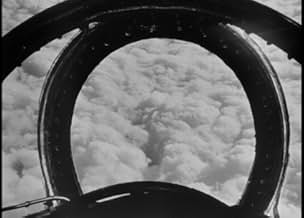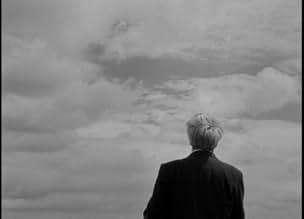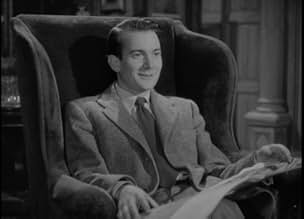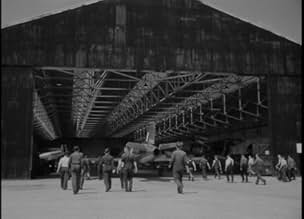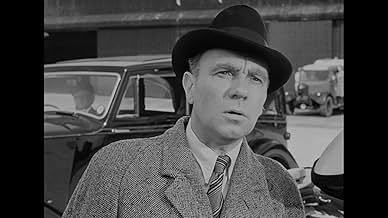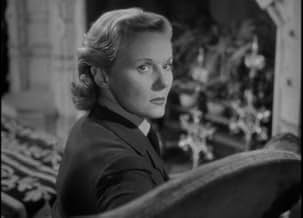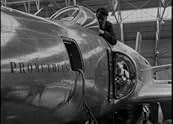IMDb रेटिंग
6.7/10
2.5 हज़ार
आपकी रेटिंग
अपनी भाषा में प्लॉट जोड़ेंFictionalized story of British aerospace engineers solving the problem of supersonic flight.Fictionalized story of British aerospace engineers solving the problem of supersonic flight.Fictionalized story of British aerospace engineers solving the problem of supersonic flight.
- 1 ऑस्कर जीते
- 9 जीत और कुल 5 नामांकन
Rodney Goodall
- Little Boy
- (बिना क्रेडिट के)
Donald Harron
- ATA Officer
- (बिना क्रेडिट के)
Vincent Holman
- Factor
- (बिना क्रेडिट के)
Jolyon Jackley
- Susan's Baby
- (बिना क्रेडिट के)
Douglas Muir
- Controller
- (बिना क्रेडिट के)
Leslie Phillips
- Controller
- (बिना क्रेडिट के)
Anthony Snell
- Peter Makepeace
- (बिना क्रेडिट के)
Sally-Jane Spencer
- Daughter of Philip
- (बिना क्रेडिट के)
Robert Brooks Turner
- Test Bed Operator
- (बिना क्रेडिट के)
फ़ीचर्ड समीक्षाएं
I first watched THE SOUND BARRIER on TV in 1975, and liked it immensely, finding it both informative and intelligent in its presentation- It keeps the viewer interested to the end, no doubt because David Lean's direction is very good, at times even inspired, and it is helped by extremely competent cinematography and a credible screenplay.
Sir Ralph Richardson is superb as JR, a man obsessed with building ever better aircraft in competition with de Havilland and other companies, to the point of driving his son (well played by Denholm Eliott) and his son in law (Nigel Patrick) to their deaths.
I also liked John Justin as the pilot who finally breaks the sound barrier.
Ann Todd, who was married to David Lean at the time, somehow does not seem right for the part. I would have liked to see Vivien Leigh or Kay Walsh in that part, as both conveyed their emotions more readily and in greater depth.
The technical aspects are succintly but clearly presented, and the discussion about the telescope and how what you see there is from 700,000 light years, and more, ago, certainly makes me realize my insignificance, every time I see THE SOUND BARRIER.
David Lean had just come from making three masterpieces. BRIEF ENCOUNTER, GREAT EXPECTATIONS and OLIVER TWIST, and this is a transitional film, which already carries some signs of the epic that would emerge with the superlative THE BRIDGE ON THE RIVER KWAI, and be continued with LAWRENCE OF ARABIA, DR ZHIVAGO, RYAN'S DAUGHTER and, just before his death, PASSAGE TO INDIA.
Recommended. 7/10
By many standards, David Lean's production of the film he directed in 1952, "The Sound Barrier" is both unusual and I suggest rewarding. The screenplay by Terence Rattigan I found to be riveting throughout. This I judge stems from the fact that its subject is men of vision, and what they do to about their greed for something unnameable, necessary and sometimes deadly. The author in the film is at pains not to paint such men as glory hunters, nor seekers after excitement alone; in one scene, the central character talks about the fliers of the past, and then suggests the men of the future will need vision even more than flying skills to conquer what awaits us--and the answer to what that is is given as "the stars"--called the final frontier in this film in all but name. There are three fliers we meet in the film at a fictitious industrial empire called Ridgefield. The boss's son who hasn't got what a flier needs, Tony, who marries his daughter and reaches his limit because he lacks the necessary genius, and Philip, who has "the right stuff". What I find extraordinary about this very well-directed cinematic tale is that it is always about the people and the joy and danger of flight at the same time, without the focus ever losing sight of the people. The music for this film was supplied by Malcolm Arnold, and it is extraordinary almost everywhere but I find never intrusive. One sequence involves one of the three pilots taking his new wife for a swift flight to Cairo from England; the scene accomplishes many things at once. She learns because of her journey, what some men see in the serenity of the sky, and even its danger; it introduces us to the third pilot and his wife; and we are given a sense of the camaraderie of the men who flew in those days; another such moment occurs when the French ace Geoffrey de Havilland is killed trying to break the sound barrier ahead of all others. Jack Hildyard and several others supplied the cinematography and aerial scenes; Elizabeth Hemminges did a fine subdued job on the costumes; Vincent Korda is credited with the Art Department's superb work while Muir Matheson is acknowledged as music director. Among the smallish cast, the pilots are all beautifully played. bright Nigel Patrick is likable ace Tony, young Denholm Elliot stands out as the boss's son, and John Justin is just right as the third of the trio, Philip. Joseph Tomelty is admirable as Will Sparks, the designer tormented by his own part in causing test pilots to risk their lives; Ann Todd is good as the tormented Susan, wife to Tony and daughter of the boss of Ridgefield. Dinah Sheridan is also lovely as Philip's brave wife; but it is Ralph Richardson's powerful realization of John Ridgefield, former pilot, towering presence and inspiring and dangerous leader of men who along with Justin gives the film its unusual dimension of mind and purpose. One may quarrel with the motivations attributed to Richardson in the last scenes; but he has been so alone in his vision and at such a cost, he may be forgiven for asking at last to be understood. The ending I find to be most satisfying, the film's climax tremendously moving. This is a great film, which has never been appreciated as it should have been. It is B/W film-making at its dramatic best for my money. Its science may not be perfect, but its depiction of human merit and what happens when that quality is lacking in a man is powerful indeed. Not to be missed.
The movie really does capture a sense of time and the tremendous bravery of those involved in the breaking of the sound barrier.The cast is excellent and as usual Denholm Elliot steals every scene he's involved in. I feel this film is under-rated and is typical of much of the good work of British Cinema in the 50's
This is an outstanding film about the human cost of progress and obsession. Richardson is great as the aviation mogul willing to pay the necessary price for reaching new realms and new worlds. Historically and technically, the film is so out in left field as to be almost laughable (the plot point about control reversal is apparently the result of a writer hearing a valid aeronautical term and misunderstanding it completely) but in the end, the issues raised and the fine performances make Sound Barrier a winner. The aerial photography is outstanding, and there is one beautifully composed shot from below the nose of the Comet airliner that perfectly emphasizes the sleek lines of that most beautiful jet.
This black and white early 50s movie shows crusty Britain at its stiff upper lip best. It is the story of mans obsession with speed, and a ruthless plane makers ambition to succeed in building a supersonic jet. Richardson plays the tycoon whose dream kills his son and son-in-law, but who finally sees the error of his ways and whose daughter returns to the cold family home with his grandson.
The film is also a vehicle to show the world Britain's proud lead in jet technology. There is a classic sequence in the film where the happy daughter and son-in-law deliver a De Havilland Vampire jet fighter to Egypt. They set off at breakfast time in England and hurtle over the English Channel, the Alps, Ancient Greece and the Pyramids before arriving in at the airfield. Of course we take this for granted now, but 47 years ago this was unheard of. The director contrasts the old ruins and remains of our ancient ancestors with the marvel of the modern age: the jet plane.
The film also introduced THE marvel of the early fifties, the De Havilland Comet jet liner. This beautiful but flawed machine was in service SIX years before any other jet liner and for a while, the world rushed to De Havillands, and Britains door. For two years the worldwide fleet gave the travelling of the future.
In every other way this is an eccentrically English film with creaky old houses, cottages with roses around the door and eccentric engineers. Shout in glorious black and white it conveys a sense of wonder and optimism in the future, whilst being thoroughly old fashioned
The film is also a vehicle to show the world Britain's proud lead in jet technology. There is a classic sequence in the film where the happy daughter and son-in-law deliver a De Havilland Vampire jet fighter to Egypt. They set off at breakfast time in England and hurtle over the English Channel, the Alps, Ancient Greece and the Pyramids before arriving in at the airfield. Of course we take this for granted now, but 47 years ago this was unheard of. The director contrasts the old ruins and remains of our ancient ancestors with the marvel of the modern age: the jet plane.
The film also introduced THE marvel of the early fifties, the De Havilland Comet jet liner. This beautiful but flawed machine was in service SIX years before any other jet liner and for a while, the world rushed to De Havillands, and Britains door. For two years the worldwide fleet gave the travelling of the future.
In every other way this is an eccentrically English film with creaky old houses, cottages with roses around the door and eccentric engineers. Shout in glorious black and white it conveys a sense of wonder and optimism in the future, whilst being thoroughly old fashioned
क्या आपको पता है
- ट्रिवियाThe flying sequences under the direction of Anthony Squire, were based at the Vickers aerodrome at Chilbolton near Nether Wallop in Hampshire. Squire managed to secure one of the last airworthy Avro Lancaster bombers for the task. The cameramen were positioned in the front and rear turrets while Squire conducted proceedings from the central astrodome. The Lancaster was replaced by a Vickers Valetta after all the crew except Squire fell asleep due to an oxygen supply failure. Luckily as he recalled, "They all woke up on the way down, like people in a fairy wood, but I didn't bother with the Lancaster again."
- गूफ़In the observatory, John tells Tony that the Andromeda galaxy is 700,000 light-years away; The best estimate since 1940 (when the known Cepheid variables were separated in two types by Baade) is 2.54 million light-years, BUT: this corresponds to 778,000 parsecs! So, it seems that parsecs and light years were somehow switched here in the movie.
- भाव
Susan Garthwaite: [regarding an image of the surface of the moon, displayed via JR's telescope] What's that?
John Ridgefield: It's the moon.
Susan Garthwaite: I never knew it could look so unfriendly.
John Ridgefield: It's an unfriendly universe.
Susan Garthwaite: Do you believe that?
John Ridgefield: Unfriendly only because it's unconscious of our existence.
- क्रेज़ी क्रेडिटIn the opening credits, immediately after the human actors, are listed four British aircraft: The de Havilland COMET The Vickers-Supermarine ATTACKER The de Havilland VAMPIRE 113 The Vickers-Supermarine SWIFT Rolls-Royce 'Avon' Engine
- कनेक्शनFeatured in Jet! When Britain Ruled the Skies: Military Marvels (2012)
- साउंडट्रैकWith Sword and Lance
(uncredited)
Music by Hermann Starke
टॉप पसंद
रेटिंग देने के लिए साइन-इन करें और वैयक्तिकृत सुझावों के लिए वॉचलिस्ट करें
- How long is The Sound Barrier?Alexa द्वारा संचालित
विवरण
- रिलीज़ की तारीख़
- कंट्री ऑफ़ ओरिजिन
- भाषा
- इस रूप में भी जाना जाता है
- Breaking the Sound Barrier
- फ़िल्माने की जगहें
- उत्पादन कंपनियां
- IMDbPro पर और कंपनी क्रेडिट देखें
बॉक्स ऑफ़िस
- बजट
- £2,50,000(अनुमानित)
- चलने की अवधि1 घंटा 58 मिनट
- रंग
- पक्ष अनुपात
- 1.37 : 1
इस पेज में योगदान दें
किसी बदलाव का सुझाव दें या अनुपलब्ध कॉन्टेंट जोड़ें


